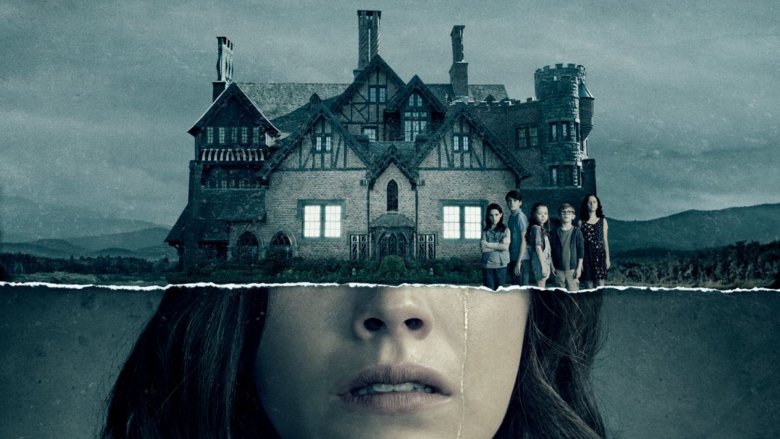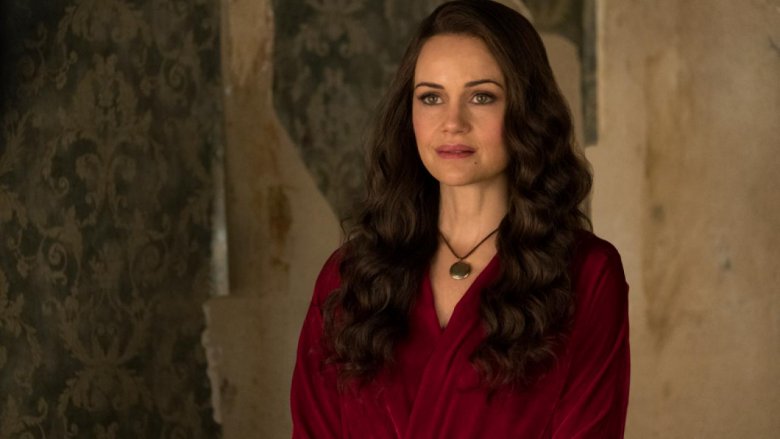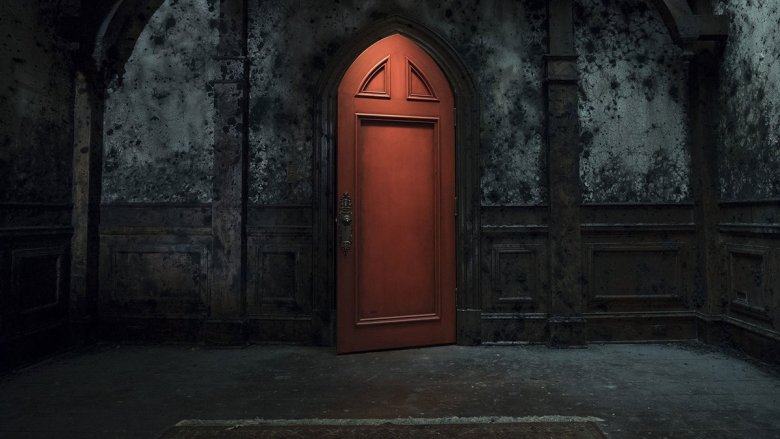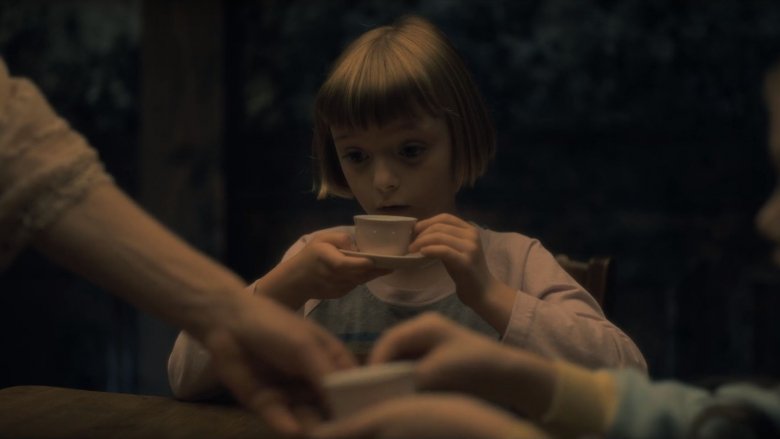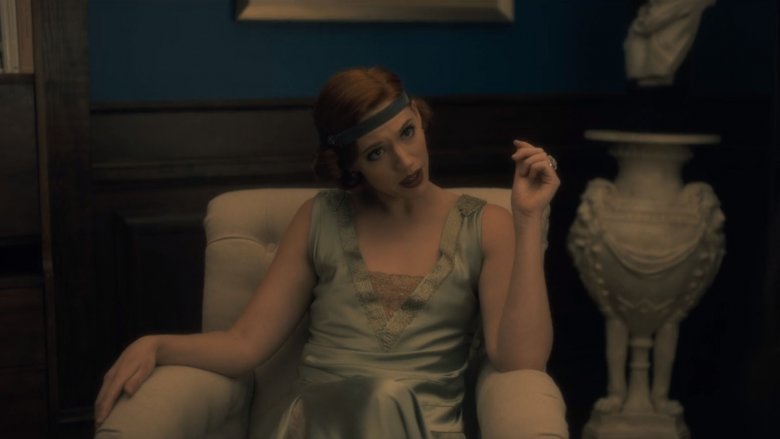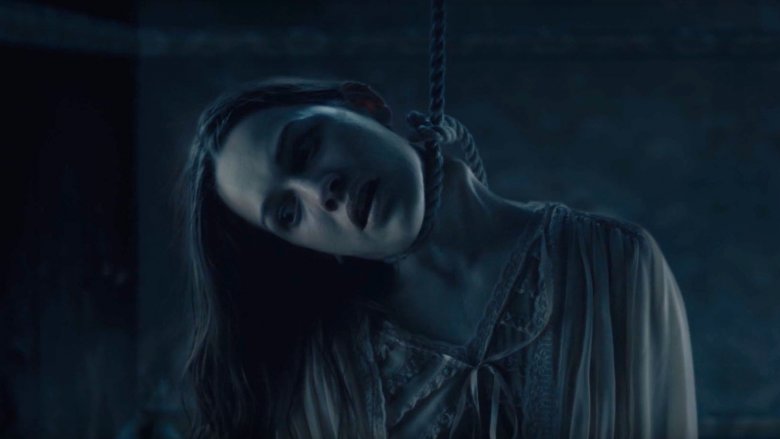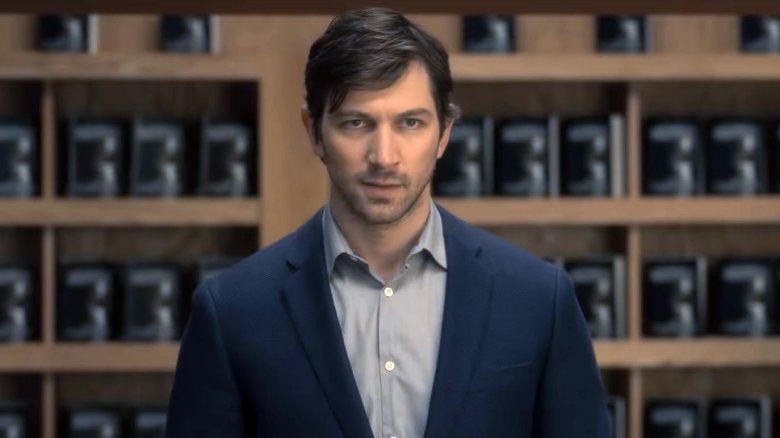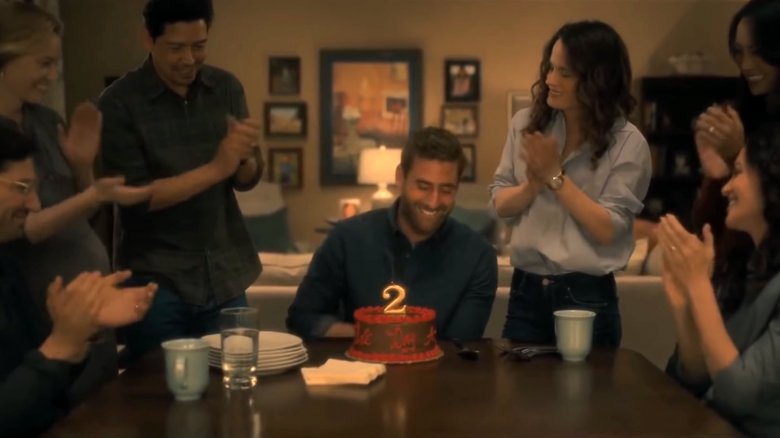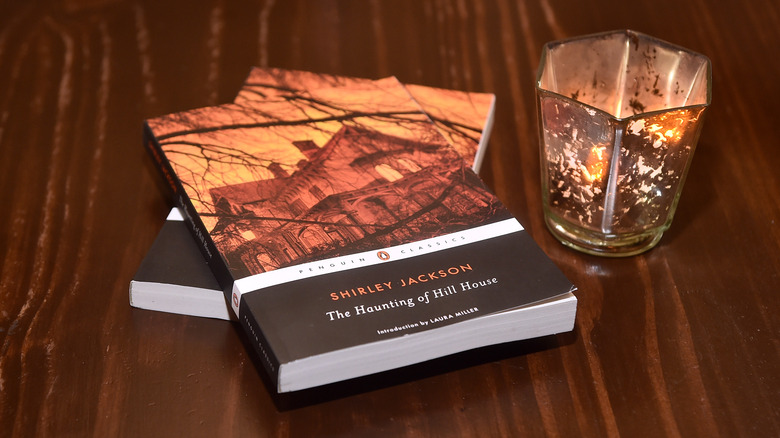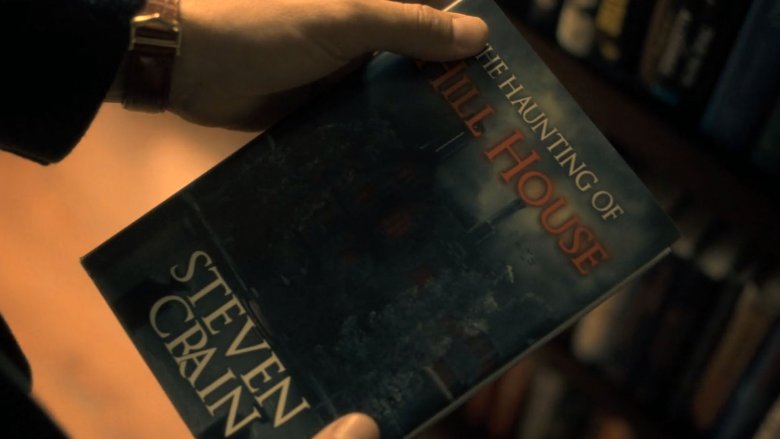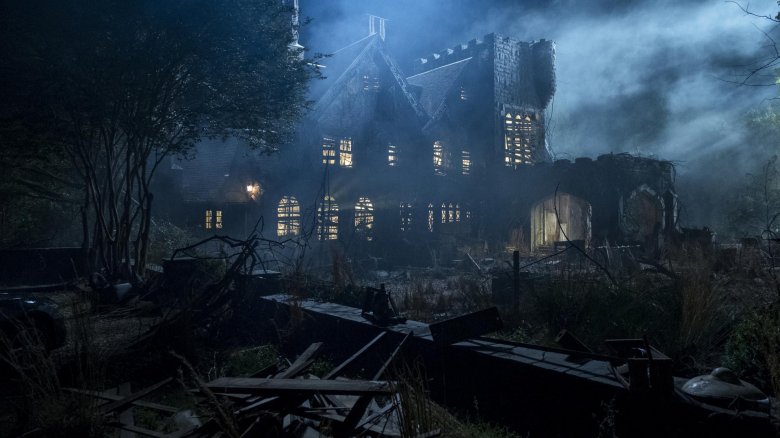The Ending Of The Haunting Of Hill House Explained
For a horror story, Netflix's The Haunting of Hill House doesn't have a typical ending. Then again, the Crain family's stately manor isn't a typical haunted house, either. Oh, Hill House is stuffed full of more spirits, spectres, and ghoulies than any other structure in television history, but they're not the bad guys. The house itself is, and that changes everything.
The Haunting of Hill House isn't a particularly subtle show, and if you're paying attention you can probably figure out what's going on — assuming you can keep all the pieces straight. The Haunting of Hill House isn't a simple ghost story. It's got time travel, psychic powers, multiple timelines, more suicides than you can shake a stick at, and a conclusion that's downright sappy. It's a lot to keep track of. Thankfully, while Hill House might be mysterious, it's not as complicated as it seems. Just watch out — there are some spoooky spoilers ahead!
The big twist: Olivia was right
Let's start with something simple. During the Crain family's last night in Hill House, Olivia Crain, wife of Hugh and mother to Steven, Shirley, Theo, Luke, and Nell, killed herself. It happened sometime between when Hugh stashed all of his kids in the car and when he returned to Hill House to check on his ailing wife. Why Olivia committed suicide and what exactly happened that night are the keys to the show's overall plot, but The Haunting of Hill House waits until the final couple of episodes to spill the beans.
Well, surprise! As it turns out, Olivia just wanted to be a good mom. See, as it turns out, if you die in Hill House your spirit is stuck there for eternity, and the mansion seems dead set on collecting as many souls as possible. To snare Olivia, it threatens her children. The house bombards Olivia with images of her two youngest kids, twins Nell and Luke, in trouble. Over time, Olivia becomes convinced that the world outside Hill House is both a figurative and literal nightmare. The only way to save the twins, she decides, is to kill them, keeping them safely ensconced in Hill House forever.
She's not wrong, either. If Olivia had successfully served her children poison-laced tea, Nell never would've ended up in Shirley's morgue and Luke wouldn't have OD'ed on a near-fatal dose of heroin. Sure, they would've died, but they never would've been hurt again. Unfortunately, Olivia isn't correct about everything: when she flings herself down the stairs, she's trying to escape a nightmare. She ends up dying instead.
The Red Room's shape-shifting secret
The Shining teases audiences with Redrum. The Haunting of Hill House does it with a Red Room. If the show has a central mystery, it's what's lurking behind that ominous red door, and why anyone can't seem to open it to peek inside? In flashbacks, The Haunting of Hill House implies that the Red Room is the source of all of the Crains' troubles — at the very least, it's the source of the black rot that dooms Hugh and Olivia's restoration — but its true nature isn't clear until the very end.
When describing the Red Room to her siblings, Nell calls it the house's "heart" before correcting herself: it's really more like the Hill House's stomach. The longer that you spend there, the more the house "digests" you. That's why the Red Room must trick its victims into staying inside by changing its form. To Olivia, it looks like a reading room. To Steven, it's a video game-filled retreat. Luke thinks it's a treehouse, Theo uses it as a dance studio, while for Shirley, it's simply a place to watch TV and unwind.
The Red Room and Hill House don't like it when a meal goes unfinished, either, which is why the Crain children spend their adult lives seeing ghosts and supernatural visions. Hill House already has its hooks in 'em. Now, it wants them to back so it can finish the job.
A not-so-imaginary friend
The third and final piece of The Haunting of Hill House puzzle is Abigail, Luke's friend. Throughout the series' flashbacks, young Luke remains adamant that his friend Abigail, who lives in the woods near Hill House, is real. Hugh insists that Abigail is made up, but the audience has little reason to doubt Luke. After all, his twin, Nell, is haunted by her own ghost, the Bent-Neck Lady. Why should Luke be any different?
Except Abigail isn't a ghost. She's a real, live human girl, at least for a little while. Hill House's caretakers, the Dudleys, have a daughter about Luke's age. However, the girl isn't allowed to visit Hill House. In fact, Mrs. Dudley rarely lets the child leave home at all. And where do the Dudleys live, you ask? Why, in a house near the woods, of course. Yup, Luke was telling the truth after all.
Ultimately, Luke invites Abigail over, and the young girl sneaks out of her parents' house to join her friends for a slumber party. It's a fatal mistake. Hugh rescues Nell and Luke from Olivia's poisoned tea but doesn't get there in time to save Abigail, and the girl dies moments later. That's not the end, though: Abigail lives on as one of Hill House's many, many ghosts, and the Dudleys convince Hugh to leave Hill House intact so they can visit their daughter. In return, they'll keep Abigail's murder a secret, saving what's left of Olivia's reputation. Hugh agrees, but on one condition: beside the Dudleys, no one else will ever enter Hill House again.
A multi-family affair
Now, Hill House doesn't speak to Olivia directly. It uses the remains of a '20s flapper to seduce her, and in case you missed it, the malevolent spirit is none other than Poppy Hill, one of Hill House's former residents. As Mrs. Dudley explains, young William Hill spent his youth in an asylum, where he met Poppy. Both of them were insane, but mental illness doesn't stand in the way of young love. Poppy and William married, and the couple spent the rest of their days in Hill House.
At some point, William bricked himself up in Hill House's basement and died there, leaving his body for Hugh to discover decades later. Poppy's daughter passed away due to illness. Her son ended up in a wheelchair, and could only communicate by pounding on the walls. In true Hill House fashion, though, that's not the end of their stories. William's ghost is the top-hat aficionado who haunts Luke. The wheelchair ghost appears throughout the series and torments the Hill children from the very first episode onward.
The Hills aren't just great villains. For Olivia, their story is a cautionary tale. Olivia worries that her kids will get hurt. Poppy's actually did. Thanks to Hill House, Olivia becomes suicidal. Same goes for William. The Hills' story parallels the Crains' in all kinds of ways, and the show wisely uses the family to establish the stakes. If the Crains aren't careful, they'll end up exactly like Poppy, William, and the rest — and that's definitely not a good thing.
The Bent-Neck Lady's secret mission
Nell's suicide is the big surprise in the first episode of The Haunting of Hill House, and the big twist in her story — Nell is the Bent-Neck Lady that's tormented her since childhood — comes in episode five, but the show waits until the very last episode to explain exactly what Nell's mission is. Unlike Hill House's other ghosts, Nell's actually trying to save people, and she's willing to travel through time to do it.
"I thought for so long that time was like a line, that our moments were laid out like dominoes and that they fell one into another," Nell's spirit says in the Red Room. "But I was wrong. It's not like that at all. Our moments fall around us like rain or snow or confetti." That's how Nell's able to show up in the past in order to try and warn her childhood self away from Hill House, or why she appears exactly when her siblings need her the most. The mansion might've gotten her, but she'll do her best to make sure that it doesn't consume anyone else.
On one hand, it's a nice redemption arc for Nell, who suffers the most at Hill House's spectral hands. On the other, it makes her story remarkably tragic. As Nell explains, there's nothing her family could've done to save her. Hill House had too strong of a hold on her, and the best that she could do was die, and then use her powers to help others. It's a noble sacrifice. For Nell, though, it also kind of sucks.
Master of stories, master of Hill House's domain
By the end of The Haunting of Hill House, there's only one living member of the Crain family who knows what happened at Olivia's fatal tea party. After the rest of the Crain children are safe, Hugh shows Steven the truth: Olivia killed the Dudleys' child, and in return for keeping the murder a secret, he's promised to keep Hill House standing.
At first, it feels like a weird choice. Steven is the one who callously profited off of the family's sordid history. He's the only one who doesn't believe in ghosts. He's kind of the worst. Why tell him the truth, not to mention charge him with upholding Hugh and the Dudleys' secret deal? The monologue that Steven gives while trying to reconcile with his wife holds the answers. "Ghosts are guilt," Steven says. "Ghosts are secrets. Ghosts are regrets and failings. But most times... most times a ghost is a wish."
In other words, ghosts are stories. You need a motive to feel guilty. You can't keep a secret if there's no information to hide. When you wish, you wish for something, and there's always a reason why you choose what you choose. Every single one of those things has a story attached, and for all of his faults, Steven is the family storyteller. With Hugh dead, Steven is both the family patriarch and the person best-equipped to keep the Crains' story alive.
The truth behind that happy ending
Let's talk about The Haunting of Hill House's closing moments. For the better part of ten episodes, it's a chilling ghost story and dark psychological drama. Then, that montage starts. Steven reconciles with his wife. Shirley and Kevin make amends. Luke stays sober. Mrs. Dudley reunites with her children in the afterlife. Hugh, Olivia, and Nell are trapped in Hill House, but they've still got each other. Even prickly, closed-off Theo ends up in a happy and stable relationship. It's not just an upbeat ending. It's a downright happy one.
That's an unusual conclusion for a horror story, and given the Red Room's various deceptions, some fans refuse to take it at face value. The Haunting of Hill House creator Mike Flanagan, on the other hand, insists that the ending really happened. "In the version we ended up going with, I think it absolutely is real," Flanagan tells Thrillist. "We committed to that course of action." Don't read too much into Steven's wife being pregnant, either. Vasectomies can be reversed, and Flanagan says that's what happened here.
Flanagan understands viewers' skepticism. "We talked for a very, very long time about putting the Red Room window... in the background" during Luke's triumphant two-year sobriety party, Flanagan says. "I ultimately decided not to. It was too cruel." Still, Flanagan seems very pleased that fans remain skeptical. "But the suspicion you had was exactly where we were," he says, "and that kind of makes me very happy."
What The Grattan Murders really means
During The Haunting of Hill House's big climax, Poppy Hill recites a little number known as "The Grattan Murders." It's an odd little ditty that details how an entire family is killed off one by one, and while the thematic parallels are obvious, what the poem means in show's bigger context isn't clear. In the absence of any real explanation, some fans are arguing the poem is there specifically to set up a second season, should Netflix choose to greenlight one.
As it turns out, however, "The Grattan Murders" is an Easter egg, albeit a pretty odd one. Not only does the poem appear in Shirley Jackson's original novel, the author used to sing it to her children before bed. Yes, a litany of grisly murders makes for an odd way to lull kids to sleep, but Jackson wasn't exactly a normal mother. See, in addition to writing horror stories and raising four children, Jackson was also a devoted occultist.
It's not clear how much of Jackson's witchcraft was genuine, how much of it was a feminist-minded political statement, and how much was a marketing gimmick, but Jackson clearly knew her stuff. She owned hundreds of books on witchcraft. She used charms to ward her house against demons. She tried (unsuccessfully) to curse the New York Yankees. Whether Jackson truly believed or not is irrelevant. She clearly had a flair for the dark and macabre, and you can see it in both her writing and especially in her choice of lullabies.
Words that speak louder than actions
Easter eggs and references aside, The Haunting of Hill House has no qualms about taking one of Shirley Jackson's best-known works and giving its authorship to a man (although, let's be honest, Steven is exactly the kind of guy who'd steal a woman's story to advance his own career). Still, while The Haunting of Hill House might've done its best to erase Jackson's accomplishments, her words still play a big part in the series, especially in the show's opening and closing moments.
The monologue that Steven delivers over the final episode's closing moments, for example? You know, the one that's really well written? Well, Steven didn't write it. Jackson did. As soon as Steven starts talking about "Hill House, not sane," he's quoting the original novel word-for-word. Well, almost word for word. The final monologue is lifted from the book, but the writers made a few small adjustments to account for the series' happier ending.
In the book, Hill House "has stood.... for 80 years." In the show, it's been there for over 100. Hill House is described in the present tense, not the past. The biggest change, though, comes in the final line. The novel ends with "silence lay steadily against the wood and stone of Hill House, and whatever walked there, walked alone." In the Netflix series, that becomes "those who walk there, walk together." Not only does the show humanize Hill House's residents, but suddenly, they've got company. If you're looking for a positive conclusion, that makes all the difference.
The story yet to be told
Even with all that, The Haunting of Hill House leaves a couple of big plot threads dangling. Even after 10 hours of television, we still don't have any idea what Hill House really is, where it came from, or what made it so darn evil.
The production staff does, though, and they almost shared the secret. Almost. "We had a whole history of Hill House that we were going to shoot," Mike Flanagan hinted. "We were going to open several episodes of the show with this kind of history.... which would show you the construction of Hill House, the history of the Hill family, who everybody was." These weren't just ideas tossed around in the writers' room, either. These segments were scripted and added to the shooting schedule.
Unfortunately, Flanagan explained, "We were running out of time and resources, and something had to go." Ultimately, that meant cutting the flashbacks. That's a shame, but you know what? Sometimes, things are scarier when they remain unexplained. Besides, the Crain family saga is over. If Netflix decides to make a second season of The Haunting of Hill House, it'll have to focus on something. Will the future reveal more of Hill House's depraved secrets? Here's hoping.
